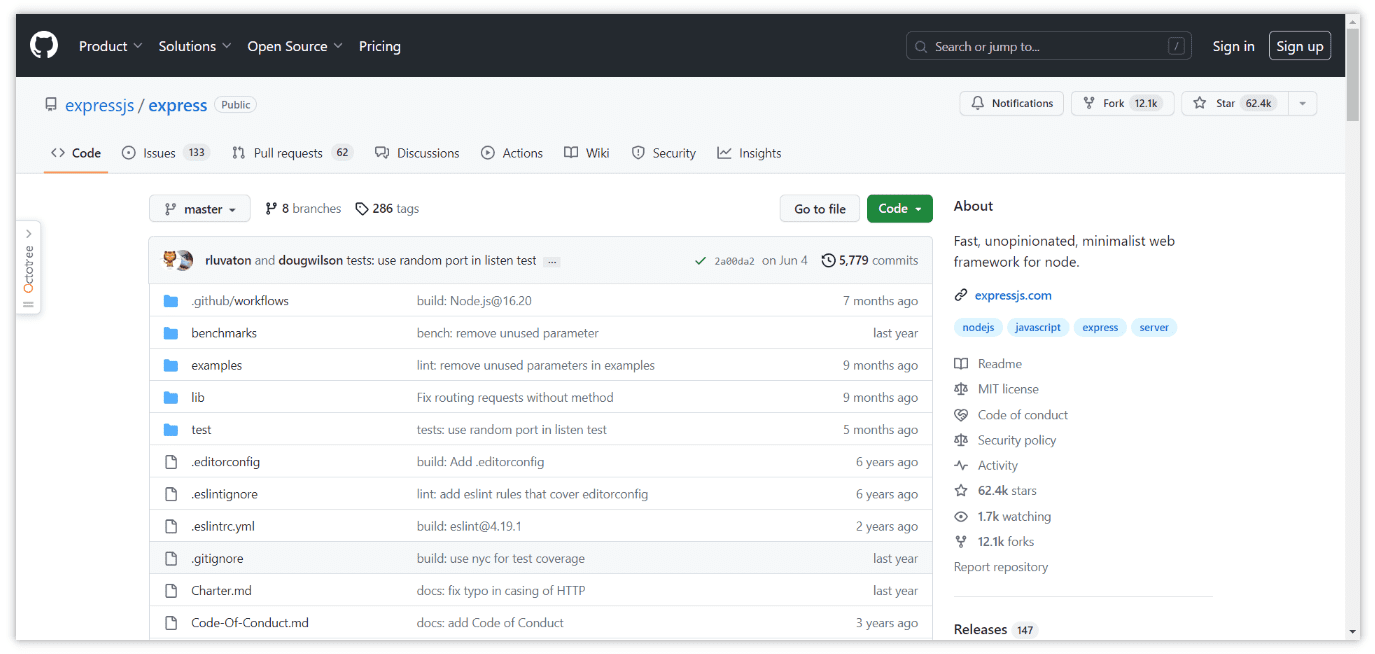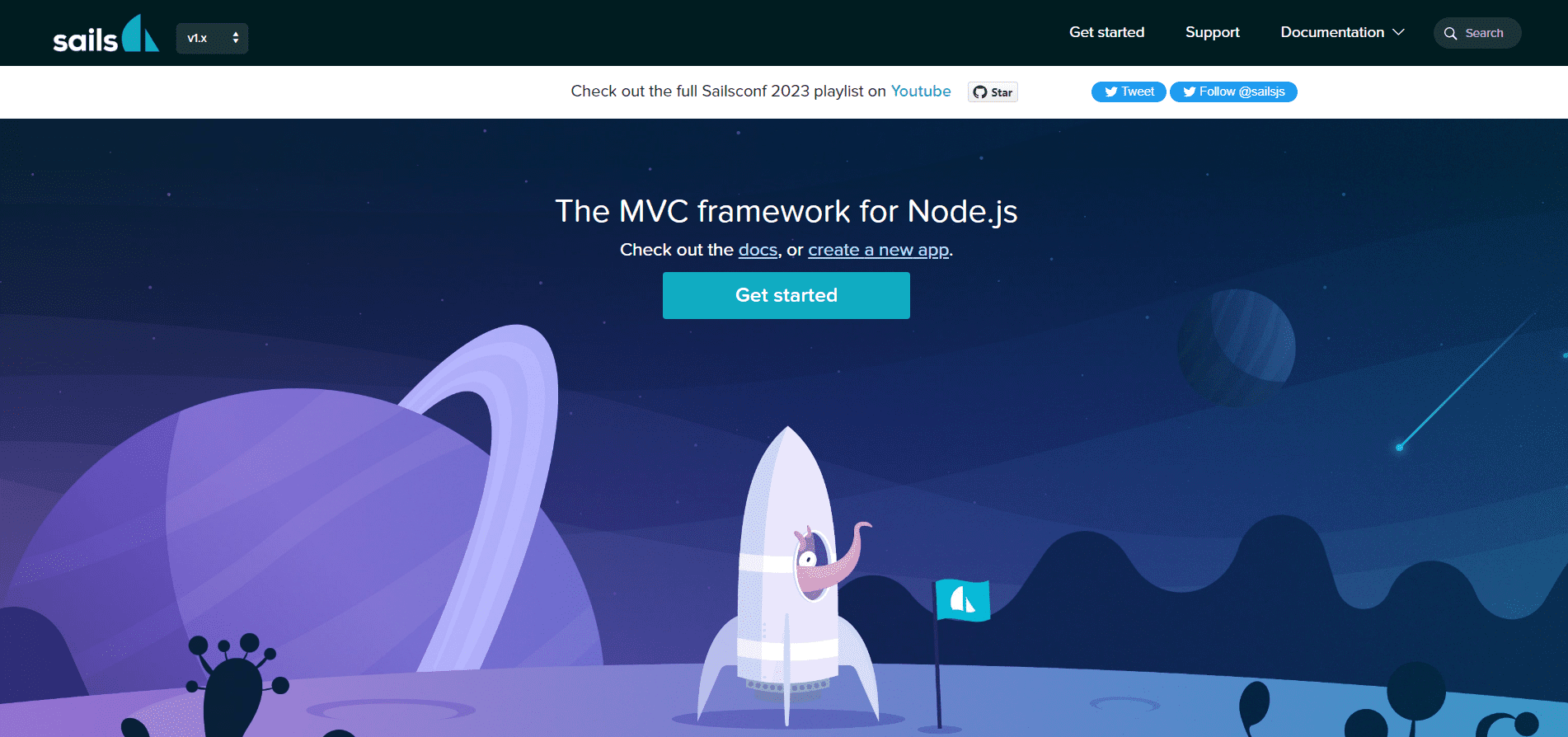2024's Most Popular Node.js Frameworks
Popular Node.js frameworks include Express.js, Nest.js, Meteor.js, Sails.js, Adonis.js, Hapi.js, and Koa.js, each offering different features and advantages for building web applications.
Node.js is an open-source, cross-platform JavaScript runtime environment that allows developers to execute server-side code using JavaScript. It utilizes the V8 JavaScript runtime engine to execute code, providing a fast and efficient way to build scalable network applications. Node.js is particularly well-suited for building real-time applications, such as web servers and chat applications, as it enables asynchronous, event-driven programming.
Node.js Framework
A Node.js framework is a set of pre-built tools, libraries, and conventions that simplify and streamline the process of building web applications using Node.js. These frameworks provide a structured foundation for developers to create server-side applications efficiently. Popular Node.js frameworks include Express.js, Nest.js, and Koa.js, each offering different features and abstractions to cater to various development needs. These frameworks often include functionalities like routing, middleware support, and template engines, enabling developers to focus on application logic rather than low-level details.
Let's now summarize the most popular Node.js frameworks of the year 2023.
Express.js
At present, Express.js has a star count of 62.4k on GitHub, making it arguably the most popular Node.js framework.Express.js stands out as a framework for Node.js due to several key features:
- Lightweight: Express.js is a lightweight framework, offering sufficient functionality without unnecessary bulk, making it ideal for building fast and efficient applications.
- Flexibility: It provides a high degree of flexibility, allowing developers to choose and use components that suit the needs of their projects without imposing excessive conventions.
- Middleware Support: The robust middleware support in Express.js simplifies the handling of requests and responses, offering a convenient way to perform tasks such as routing, validation, and logging.
- Routing System: The simple yet powerful routing system helps manage different endpoints of the application, making it intuitive and easy to maintain when handling various requests.
- Active Community: With a large and active community, Express.js ensures developers can easily access support, plugins, and relevant documentation.
The most popular features include its user-friendly API, flexible routing system, and powerful middleware support. Developers can quickly build scalable and high-performance web applications with Express.js.
The official website of Express.js is: https://expressjs.com/

Koa.js
At present, Koa.js has a star count of 34.5k on GitHub, making it a highly popular Node.js framework as well.Koa.js, as a framework for Node.js, stands out for the following reasons:
- Asynchronous Flow Control: Koa.js leverages asynchronous functions and
async/await, making the handling of requests and middleware more concise and readable, effectively avoiding callback hell. - Lightweight: Compared to other frameworks, Koa.js is more lightweight, providing essential core functionality. This allows developers greater flexibility in choosing and configuring middleware to meet project requirements.
- Non-Intrusive Design: Koa.js is designed to be non-intrusive, allowing developers to choose plugins that suit their projects without being forced to integrate a predefined set of features.
- More Flexible Context Object: The context object (Context) in Koa.js provides more control and a richer API, enabling developers to intuitively handle requests and responses.
- Middleware-First Approach: Koa.js places middleware at the core, modularizing the application's logic for ease of expansion and maintenance.
The most popular features include its asynchronous flow control design, lightweight framework structure, and flexible middleware configuration. Developers can build highly maintainable and scalable applications with Koa.js.
The official website of Koa.js is: https://koajs.com/

Nest.js
At present, Nest.js has a star count of 61.3k on GitHub, and its growth rate is remarkably fast. It is likely that in the near future, it will surpass the Express.js framework.Perhaps by the time you read this article, it has already been surpassed.Nest.js, as a framework for Node.js, stands out for the following reasons:
- Modular Architecture: Nest.js encourages the use of a modular approach to organize code, resulting in a clearer project structure, enhanced maintainability, and improved team collaboration.
- Built on TypeScript: Nest.js is built on TypeScript, providing developers with strong type checking, intelligent code completion, and an overall better development experience, contributing to the reduction of potential runtime errors.
- Dependency Injection: Nest.js introduces a dependency injection mechanism, making component creation and management more flexible, and enhancing code testability and reusability.
- GraphQL Support: Nest.js provides native support for GraphQL, allowing developers to more easily build powerful and flexible APIs.
- Robust Middleware Support: With powerful middleware support, Nest.js can handle various aspects such as request processing, authentication, logging, and more. This allows developers to finely control the behavior of their applications.
The most popular features include its modular architecture, development with TypeScript, dependency injection mechanism, and native support for GraphQL. These features make Nest.js a powerful framework suitable for building complex applications.
The official website of Nest.js is: https://nestjs.com/

Meteor.js
At present, Meteor.js has a star count of 43.9k on GitHub, making it a highly popular Node.js framework as well.Of course, Meteor.js is not just a Node.js framework; it encompasses functionalities across the frontend, backend, and database layers, facilitating the convenient construction of modern web applications.
Meteor.js is a full-stack JavaScript framework designed for building modern web applications. It provides a comprehensive set of tools and libraries that cover both the frontend, backend, and database layers, allowing developers to engage in end-to-end application development using the same language—JavaScript.
One of Meteor.js' notable features is real-time data transfer, achieved through WebSocket technology, facilitating seamless and bidirectional communication between the server and client for building real-time updating applications. Additionally, Meteor.js integrates a package management system called "Meteor Atmosphere," enabling developers to easily share and use third-party packages to extend application functionality. The full-stack nature of Meteor.js, coupled with its streamlined development process, positions it as a powerful tool for constructing rapid prototypes and real-time applications.

Sails.js
At present, Sails.js has a star count of 22.7k on GitHub, indicating its popularity within the developer community.Sails.js, as a framework for Node.js, excels in the following aspects:
- Automatic Blueprint API Generation: Sails.js provides an automatic blueprint API generation tool, streamlining the process of creating RESTful APIs. This allows developers to rapidly build standardized APIs.
- Real-time Capabilities: Sails.js supports the development of real-time applications, facilitating instant bidirectional communication through WebSocket technology. This makes it convenient to build real-time applications such as chat programs and notification systems.
- Data-Driven Design: Embracing a data-driven design philosophy, Sails.js' Model-View-Controller (MVC) architecture ensures intuitive and efficient management and presentation of data.
- Flexible Plugin System: With a flexible plugin system, Sails.js enables developers to easily integrate third-party functionalities based on project requirements, enhancing the framework's extensibility.
- Community Support: Sails.js boasts an active and extensive developer community, making it easier for developers to access support, plugins, and relevant documentation.
The most popular features include automatic blueprint API generation, support for real-time applications, data-driven design, and a flexible plugin system. These characteristics position Sails.js as a powerful framework suitable for building modern web applications of various scales.
The official website of Sails.js is: https://sailsjs.com/

Adonis.js
At present, Adonis.js has a star count of 14.5k on GitHub, indicating its widespread popularity.Adonis.js, as a framework for Node.js, stands out for several reasons:
- Robust ORM Support: Adonis.js comes with a powerful Object-Relational Mapping (ORM) tool, simplifying and streamlining interactions with databases. This facilitates straightforward data operations and enhances development efficiency.
- Emphasis on Security: Adonis.js prioritizes security by providing features such as Cross-Site Scripting (XSS) and Cross-Site Request Forgery (CSRF) protection, aiding developers in building more secure applications.
- Layered Architecture: Adopting a layered Model-View-Controller (MVC) architecture, Adonis.js allows for flexible organization and extension of applications while promoting code maintainability.
- Effortless RESTful API Development: Adonis.js offers convenient tools that support developers in easily building RESTful APIs, including routing, controllers, and more.
- Flexible Plugin System: With a flexible plugin system, developers can seamlessly integrate third-party functionalities based on project requirements, enhancing the framework's extensibility.
The most popular features include ORM support, enhanced security measures, layered architecture, RESTful API development support, and a flexible plugin system. These characteristics make Adonis.js a powerful and comprehensive Node.js framework.
The official website of Adonis.js is: https://adonisjs.com/

Hapi.js
At present, Hapi.js has a star count of 14.4k on GitHub, indicating its significant popularity. It is closely matched with the Adonis.js framework. It remains to be seen what development trends these two outstanding frameworks will experience in the future, and I am also eager to see their further evolution.Hapi.js, as a framework for Node.js, excels in several aspects:
- Configuration-Driven Design: Hapi.js adopts a configuration-driven design philosophy, allowing developers to define the application's behavior through simple configuration files, enhancing code readability and maintainability.
- Plugin System: With a powerful plugin system, Hapi.js enables developers to split applications into small, independent modules, making it easier to extend and maintain the application.
- Clear Route Definitions: Hapi.js provides clear and flexible route definitions, making request handling and API construction intuitive and straightforward.
- Pluggability: Highly pluggable, Hapi.js allows developers to selectively add or remove features based on project requirements, achieving a high degree of customization.
- Server-Side Rendering Support: Hapi.js offers robust support for Server-Side Rendering, facilitating the convenient construction of Multi-Page Applications (MPA).
The most popular features include its configuration-driven design, powerful plugin system, clear route definitions, high pluggability, and support for server-side rendering. These characteristics make Hapi.js a flexible and powerful Node.js framework.
The official website of Hapi.js is: https://hapi.dev/

Conclusion
In summary, Node.js frameworks offer a variety of powerful and flexible options for building modern web applications. Express.js stands out with its lightweight and flexible design, making it a widely popular choice. Nest.js adopts a modular approach, coupled with TypeScript's strong typing support, providing a more structured foundation for building complex applications. Koa.js emphasizes asynchronous flow control, simplifying the handling of requests and middleware.
Meteor.js provides an all-in-one solution for full-stack JavaScript development, streamlining the application development process. Sails.js excels with features such as automatic blueprint API generation, real-time application support, and a flexible plugin system.
Adonis.js emphasizes ORM support, security, and a layered architecture, demonstrating excellence in modern web application development. Hapi.js, with its configuration-driven design, robust plugin system, and server-side rendering support, distinguishes itself prominently. Both frameworks showcase significant popularity on GitHub.
Looking ahead, we anticipate seeing how these frameworks continue to evolve and innovate to meet the ever-changing demands of web development. Whether it's the lightweight Express.js, modular Nest.js, or comprehensive Meteor.js, these frameworks demonstrate the diversity and vitality of Node.js in the web development landscape. This diversity provides developers with more choices to better cater to the specific needs of their projects.
Learn more:
ZGY:Share more fun programming knowledge.
